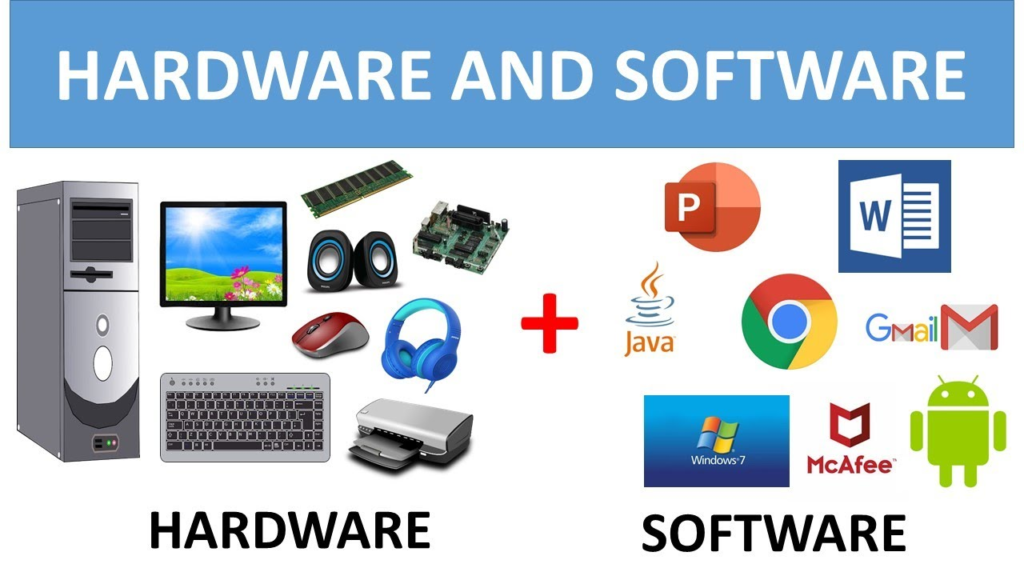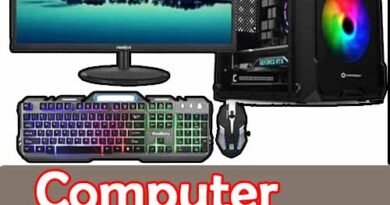Computer Class Notes 4

What is Hardware ?
Hardware refers to the physical components and devices that make up a computer system or any electronic device. It encompasses all the tangible parts of a computer or electronic system that you can touch and see. Hardware includes components such as:
- Central Processing Unit (CPU): The brain of the computer, responsible for executing instructions and performing calculations.
- Memory (RAM): Temporary storage that the CPU uses to store data and program instructions while they are being processed.
- Storage Devices: These include hard disk drives (HDDs) and solid-state drives (SSDs), which provide long-term storage for data and programs.
- Motherboard: The main circuit board of a computer, which connects and allows communication between various hardware components.
- Input Devices: Hardware like keyboards, mice, and touchscreens that allow users to input data and interact with the computer.
- Output Devices: Hardware like monitors, printers, and speakers that display or provide output from the computer.
- Graphics Processing Unit (GPU): A specialized hardware component designed to handle graphics and image processing tasks.
- Network Interface Cards (NIC): Hardware used to connect the computer to a network, such as Ethernet or Wi-Fi adapters.
- Power Supply Unit (PSU): Provides electrical power to the computer’s components.
- Optical Drives: Devices like CD/DVD drives used for reading and writing optical discs.
- Expansion Cards: Add-on hardware components that can be inserted into slots on the motherboard to enhance functionality (e.g., graphics cards, sound cards).
- Cables and Connectors: The physical wiring and connectors that enable connections between various hardware components.
- Cooling Systems: Hardware components like fans and heat sinks that help regulate the temperature of the computer to prevent overheating.
- Peripherals: Additional hardware devices that can be attached to a computer, such as external hard drives, webcams, and game controllers.
Hardware is an essential part of any computing system, and it works in conjunction with software (programs and operating systems) to perform various tasks and functions. The combination of hardware and software enables computers and electronic devices to carry out a wide range of functions, from basic calculations to complex tasks like running applications, playing games, and accessing the internet.
What is shoftware ?

It seems like there might be a typo or a misspelling in your question. I assume you’re asking about “software” instead of “shoftware.”
Software refers to the non-tangible programs, instructions, and data that enable a computer or electronic device to perform specific tasks and functions. It is the opposite of hardware, which consists of physical components. Software encompasses a wide range of applications, programs, and operating systems that can be installed and run on hardware to perform various functions.
Here are some common categories of software:
- Operating Systems (OS): These manage hardware resources and provide a platform for running other software applications. Examples include Microsoft Windows, macOS, and Linux.
- Application Software: These are programs designed to perform specific tasks or functions for users. Examples include word processors (e.g., Microsoft Word), web browsers (e.g., Google Chrome), and image editing software (e.g., Adobe Photoshop).
- Utility Software: These programs serve to manage and maintain the computer system, such as antivirus software, disk cleanup tools, and backup software.
- Programming Languages and Development Tools: These enable software developers to create new software applications and programs. Examples include Python, Java, and integrated development environments (IDEs) like Visual Studio.

- Database Management Systems (DBMS): These software systems manage and organize data in databases, allowing users to store, retrieve, and manipulate data efficiently. Examples include MySQL and Microsoft SQL Server.
- Games: Video games and computer games are also a form of software, designed for entertainment purposes.
Software can be distributed in various forms, including downloadable applications, physical media (like CDs or DVDs), or cloud-based services accessed over the internet. It is a crucial component of modern computing, as it instructs hardware on how to perform specific tasks and enables users to interact with and utilize their devices effectively.
- Commercial Software: Developed by companies and sold to consumers or businesses. Examples include Microsoft Office, Adobe Creative Cloud, and various video games.
- Open Source Software: Developed collaboratively by a community of volunteers or organizations, with the source code freely available for modification and distribution. Examples include the Linux operating system, the Mozilla Firefox web browser, and the LibreOffice office suite.
- Custom Software: Developed specifically for individual organizations or users to meet their unique needs.
- Web Applications: Software accessed through web browsers, such as online email services, social media platforms, and cloud-based productivity tools like Google Workspace (formerly G Suite).
- Mobile Apps: Software designed for mobile devices like smartphones and tablets, available through app stores like Apple’s App Store and Google Play Store.
- Embedded Software: Software embedded in devices and hardware, such as firmware in routers, smart TVs, and IoT (Internet of Things) devices.
- Scientific and Research Software: Specialized software used in various fields, including scientific research, engineering, healthcare, and more.
- Gaming Software: A vast array of video games and gaming-related software, including game engines and development tools.
The sheer number and diversity of software programs available today make it impossible to provide an exact count. Additionally, new software is constantly being developed, while older software may become obsolete or discontinued. The software industry is dynamic and continually evolving to meet changing needs and technological advancements.





